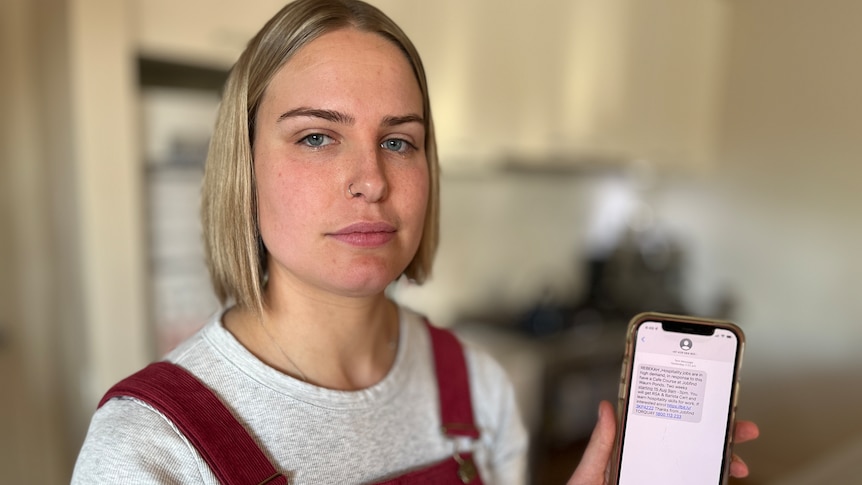Community childcare center director Rebecca Stiles is close to breaking point.
Key points:
- Childcare centers around Australia are experiencing high turnovers in staff
- Low wages have been recognized as a problem in the sector
- There are also calls for the government to restructure the sector, as more than 70 per cent of service providers are for-profit operations
After 27 years in the industry, she’s now contemplating what was once unthinkable – joining the exodus from childcare and education.
“That’s actually heartbreaking, to think that crosses my mind, to move on to somewhere else,” she told 7.30.
The reason for her growing stress is staff shortages at her community center at Hillbank, in Adelaide.
“Sometimes I wonder how I cope,” she said.
“I do find I spend most of my time staring at my roster at my desk, wondering what I’m going to do for that afternoon or the next day.”
It’s a similar story across the country.
“It was critical before COVID,” said Elizabeth Death, the chief executive of the industry body Early Learning and Child Care Australia (ELACCA).
“It’s now even more dire.”
There is broad agreement about the root cause of the problem – wages in the sector are just too low.
Working in the sector requires at least a diploma qualification or a bachelor’s degree, but many early childcare educators receive little more than the minimum wage of around $24 an hour.
“You can have a degree and work in an early education setting, and exactly the same degree will allow you to earn at least 30 per cent more if you worked in a school,” said Helen Gibbons, the director of early education at the United Workers Union (UWU).
“It’s just obscene.
“They’ve [early educators] really voted with their feet over the past six months.
“I don’t think there’s a center in the country that is not currently advertising for an early educator.”
Brisbane early childhood teacher Samira Shire said she felt undervalued.
“Our wages are one of the lowest in the country — I can’t say it’s the lowest, but it’s really quite close,” she said.
“The bit that bugs me when I read comments from the community is always how people think that we are not qualified, how people think that only a percentage of a center is working as qualified educators and the rest are working without qualification — that’s not the case.”
Impact on children
The high turnover of staff can have a devastating effect on the quality of care and education, according to developmental psychologist Karen Thorpe from the University of Queensland’s Brain Institute.
“Some of our research that we’ve recently reported shows that emotional attachment, and that emotional support and emotional quality of care, has effects on children’s language development, but also we’ve done some data linkage to show it has effects right through to secondary education,” she said.
Professor Thorpe said there was an overwhelmingly strong case for the federal government to invest more money into early childhood care and learning in order to improve wages and conditions.
“We need to more strongly advocate that these are not just childcare workers,” she said.
“They are seriously important educators at the most serious point in human development.”
Measures to improve pay
Apart from providing more federal funds, one of the obstacles to improving pay rates in the sector is the present structure of Australia’s industrial relations system, according to gender pay expert Meg Smith from the University of Western Sydney.
“There’s only been one successful equal remuneration order in the past 20 years, and I think that speaks to some of the challenges,” she said.
However, Dr Smith said she was encouraged by the Albanese government’s pledge to strengthen the gender equity section of the Fair Work Commission and supporting legislation.
“I am optimistic if those changes are to be implemented and to have applications across multiple paths of the Fair Work Act, I would be optimistic that there’s a capacity for change,” she said.
The UWU has organized a national shutdown of the early childhood education and care sector on September 7 to highlight these wage issues and is also calling for a more substantial restructuring of the industry.
A recent Australia Institute report found 77 per cent of service providers are private, for-profit operators — one of the highest rates among OECD countries.
“To achieve the aim that ECEC [Early Childhood Education and Care] in Australia becomes an essential service, like Medicare, it has to be delivered more on a basis of public need than private profit,” Andrew Scott of Deakin University and convenor of the Australia Institute’s Nordic Policy Center said.
“To sustain adequate public expenditure on childcare, and to avoid further escalating fees for parents in Australia, there will need to be less reliance in future on paying subsidies to private, for-profit operators.”
The UWU’s Helen Gibbons said there was a “creeping commercialization” in the sector.
“We have seen an increasing number of for-profit providers – private companies and private equity – making a lot of money off taxpayers,” she said.
“And it’s going to profit, it’s not going to little children … [it’s] certainly not going to early educators.
“It’s a crazy system.”
ELACCA’s Elizabeth Death disagrees.
She said Australia had strict quality controls that allowed a mixed market to operate effectively, and the government’s immediate focus should be on fixing the staffing crisis.
“I think the most important factor here is not trying to turn the sector upside down at a time we have a workforce crisis, [and] at a time our children need the best, most consistent education care.”
Watch this story on 7.30 on ABC TV and ABC iview.
.


